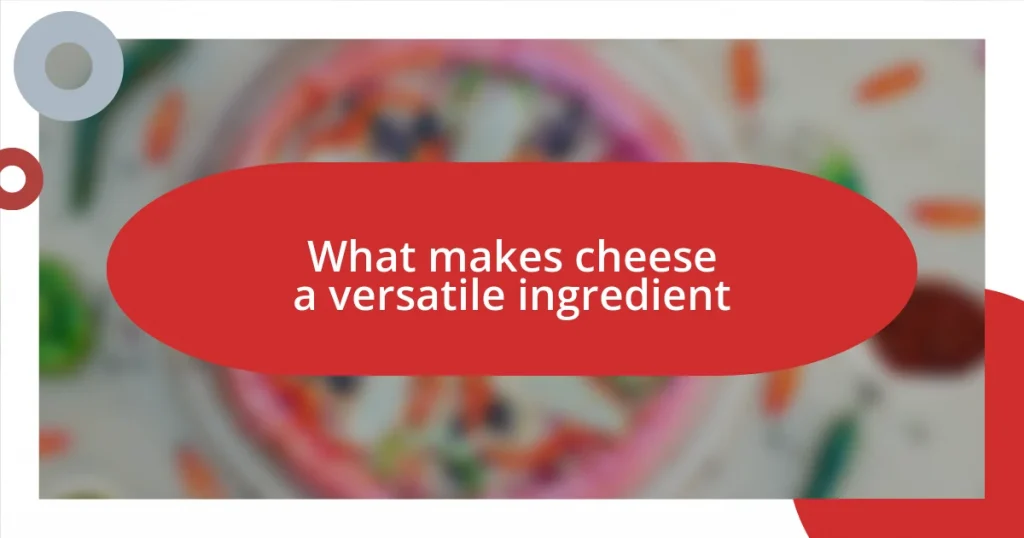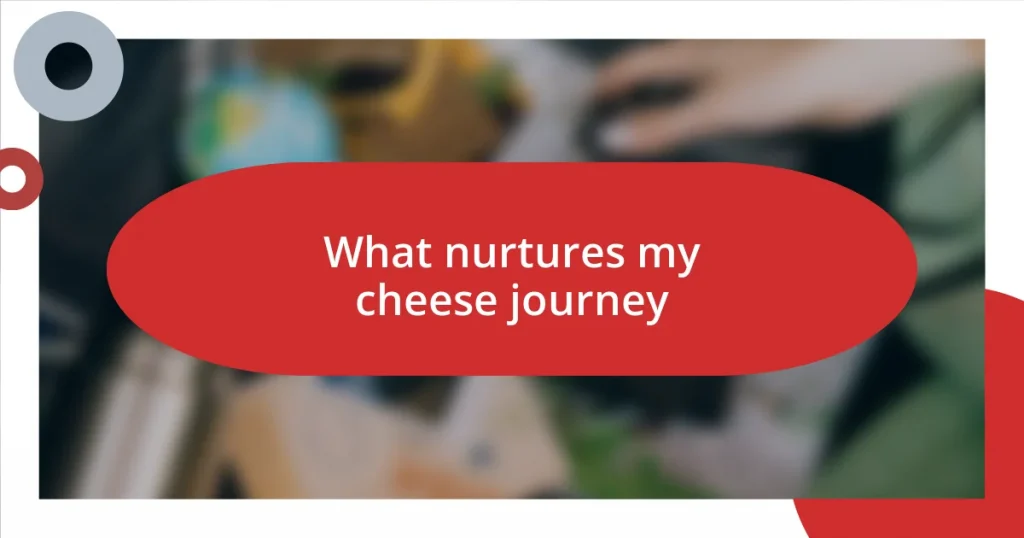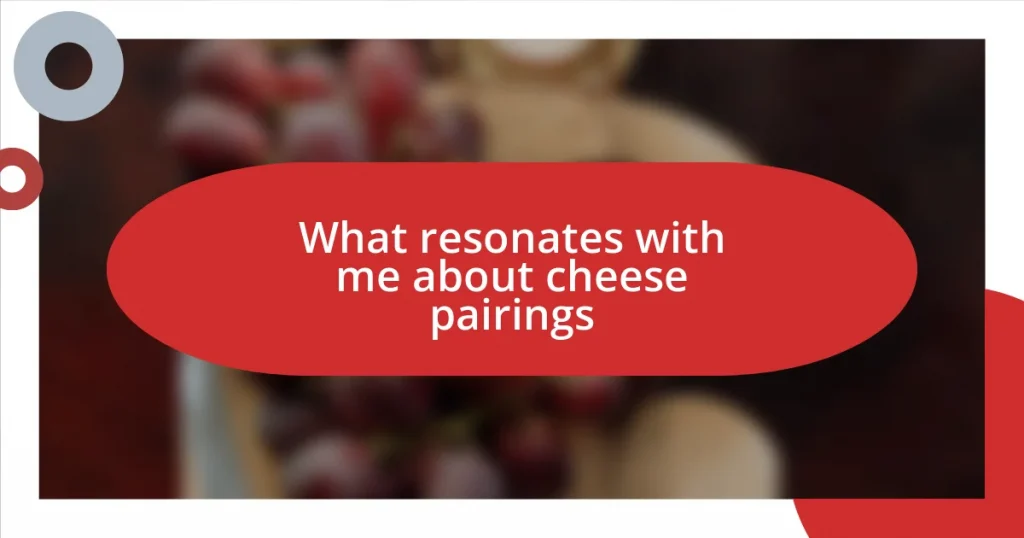Key takeaways:
- Cheese’s versatility allows it to enhance both sweet and savory dishes, making meals transformative experiences through its diverse flavors and textures.
- Pairing techniques such as contrast, complementing, and seasonal pairings create delightful combinations, elevating the tasting experience.
- Cheese plays a significant role in various cuisines globally, contributing to comfort food classics and fostering connection and nostalgia among diners.
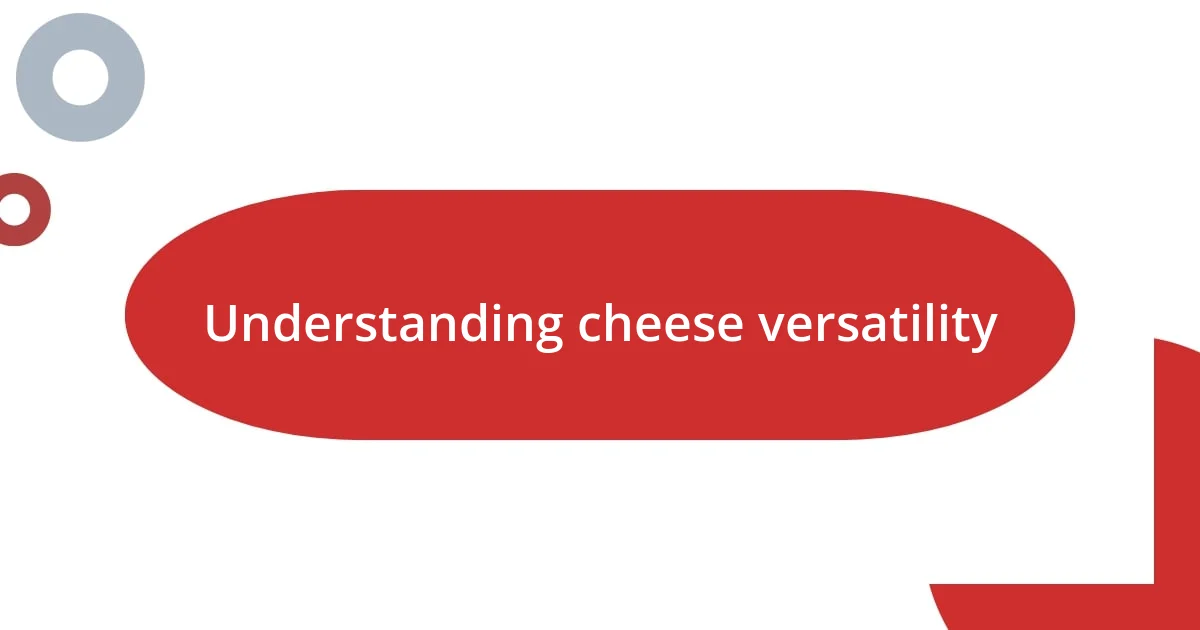
Understanding cheese versatility
Cheese is incredibly versatile, and it often surprises me how many ways it can be incorporated into dishes. For instance, I remember a dinner party where I made a simple pasta dish with three different cheeses – mozzarella, parmesan, and gorgonzola. Each cheese brought its own unique flavor and texture, transforming a basic recipe into something extraordinary.
When I think about cheese’s adaptability, I can’t help but wonder: why does it pair so beautifully with both sweet and savory foods? I’ve enjoyed creamy brie atop a sweet fig jam crostini; the contrast was nothing short of heavenly. It’s moments like these that really highlight how cheese can bridge flavors and elevate a dish’s profile.
Moreover, the range of cheese types—from creamy to crumbly, mild to sharp—means there’s likely a perfect cheese for any culinary creation. Just the other day, I was experimenting with a homemade pizza. I combined sharp cheddar and delicate goats cheese, achieving a harmony that made each bite feel like a delectable adventure. Cheese doesn’t just complete a meal; it transforms it into an experience, doesn’t it?
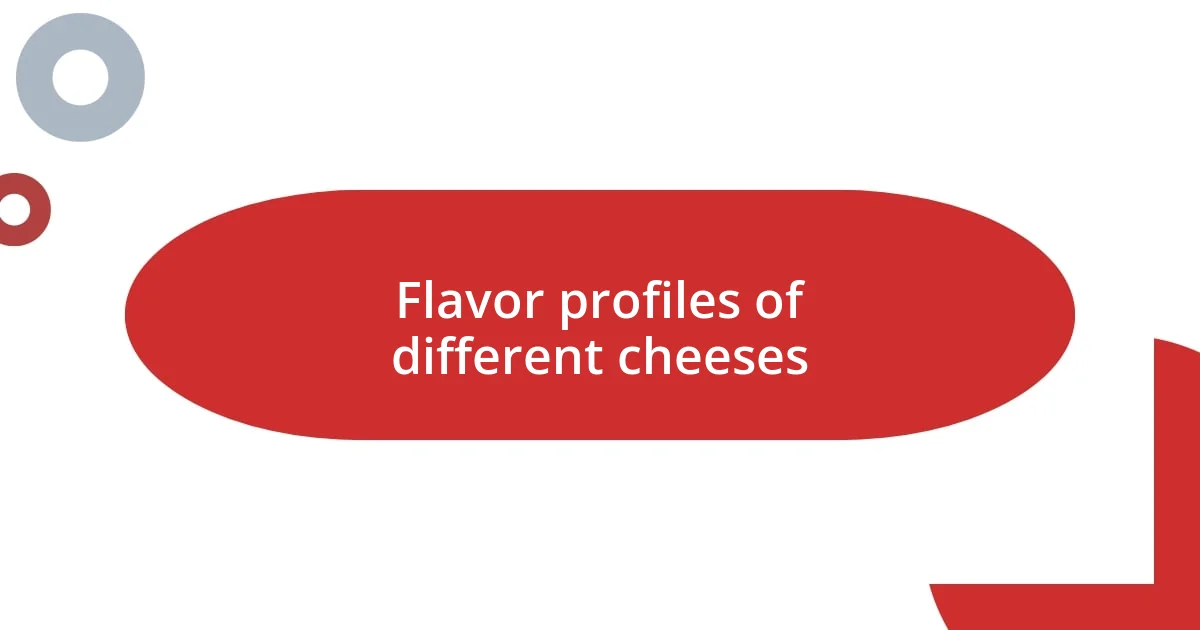
Flavor profiles of different cheeses
When diving into the flavor profiles of different cheeses, I often find myself enchanted by the diversity each type brings to the table. For example, the sharp tang of aged cheddar can invigorate a simple grilled cheese sandwich, whereas a smooth, nutty Gruyère might transform an ordinary French onion soup into something soul-warming. This spectrum is what makes cheese so alluring.
Here’s a brief overview of some notable cheese flavor profiles:
- Mozzarella: Mild and milky, perfect for fresh caprese salads.
- Parmesan: Nutty and crystalline, brings depth to pastas and salads.
- Gorgonzola: Creamy with a pungent bite, ideal for dressings or on a cheese board.
- Brie: Buttery and earthy, pairs wonderfully with fruits and crackers.
- Cheddar: Range from mild to sharp, adding a hearty flavor to burgers or mac and cheese.
- Goat Cheese: Tangy and fresh, enhances both savory and sweet dishes beautifully.
I remember the first time I tried Roquefort—it was like a revelation. Its bold, blue veins delivered an unexpected punch that turned an ordinary steak into an indulgent experience. The complexity of cheese flavors can evoke emotions, making the mundane feel extraordinary.

Cheese pairing techniques
Cheese pairing techniques are both fun and rewarding, often leading to surprising flavor combinations. One technique I frequently use is the contrast principle, where I pair a creamy cheese like mascarpone with something crunchy, like caramelized nuts. The textures and tastes play off each other, creating a delightful balance that keeps my palate interested. Have you ever tried pairing a strong blue cheese with a sweet honey drizzle? I have, and the way the flavors intensified each other left me craving more.
Another technique worth noting is the complementing pair, which involves matching similar flavor profiles. For instance, I experimented with aged gouda and a rich, dark beer at a gathering with friends. The nutty taste of the gouda mirrored the maltiness of the beer, leading to a harmonious experience that everyone seemed to enjoy. Think about your favorite cheese and drink pairings; how do the flavors meld together for you?
Lastly, seasonal cheese pairing changes the whole experience. For instance, during the summer, I love to enjoy a light chèvre with fresh herbs and ripe tomatoes. It’s like a burst of colors and flavors that feels refreshing. On the other hand, in winter, a rich, aged cheddar alongside spiced apple slices can be so comforting. The joy of discovering which cheese suits your mood or the season is part of what makes cheese an endlessly versatile ingredient.
| Technique | Description |
|---|---|
| Contrast Principle | Combining creamy cheeses with crunchy elements for a delightful balance. |
| Complementing Pair | Matching similar flavor profiles for a harmonious experience. |
| Seasonal Pairing | Using cheese and ingredients that reflect the current season for a refreshing or comforting experience. |
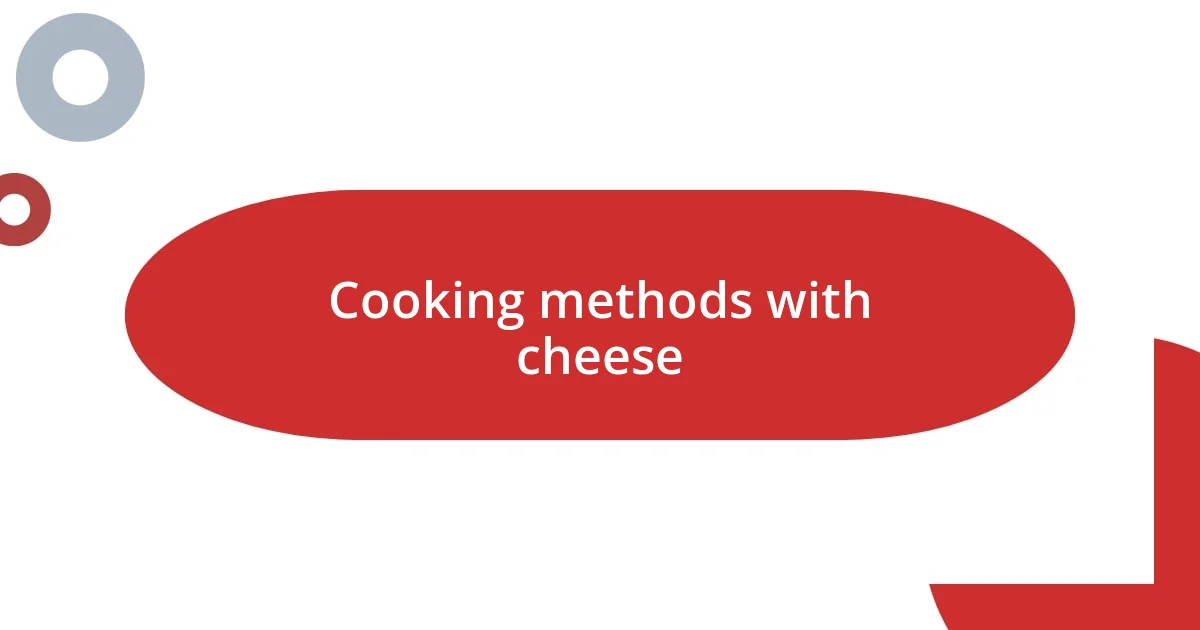
Cooking methods with cheese
When it comes to cooking with cheese, there’s an endless list of methods that can elevate dishes to a whole new level. One of my favorite techniques is melting cheese—there’s just something magical about the way it transforms a dish. Whether it’s a gooey mozzarella on a pizza or a rich fondue, the experience is both comforting and indulgent. Have you ever dipped bread into hot cheese? The texture and flavor create a moment that’s hard to replicate.
Baking with cheese is another method that never fails to impress. I recall a time when I made a savory cheese souffle, a dish that seems daunting but is surprisingly straightforward. When it came out of the oven, golden and puffed, I couldn’t help but admire how the cheese added this delightful richness. The first bite—light and airy with bursts of flavor—was pure joy. It’s amazing how just a few ingredients can combine with cheese to create something so elegant.
Grating cheese is a technique I often rely on for enhancing flavor. Sprinkling freshly grated Parmesan over a simple bowl of pasta or a vibrant salad transforms the dish completely. I remember hosting a casual dinner and deciding to elevate the meal with a generous amount of freshly grated cheese. The smiles around the table told me everything; that little touch created a shared moment of delight and appreciation among friends. Isn’t it fascinating how cheese can bridge connections and elevate the simplest meals into cherished memories?
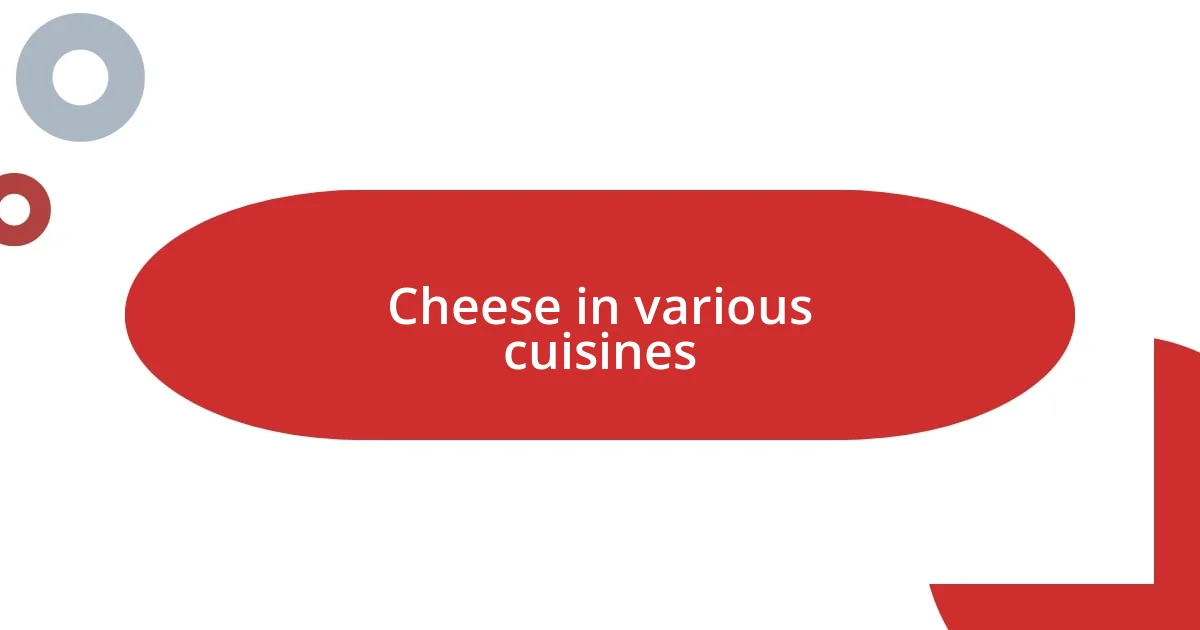
Cheese in various cuisines
Cheese plays an integral role in numerous cuisines around the world, each adding its own unique flair and character. I vividly remember enjoying a traditional Italian lasagna at a friend’s family gathering. Layers of rich ricotta, gooey mozzarella, and aged parmesan melded together create a symphony of flavors that resonated deeply with everyone at the table. Have you ever tasted a dish that made you feel like you were part of a different culture?
In Mexican cuisine, cheese transforms dishes into comfort food classics. One of my favorite moments was trying quesadillas filled with oozing Oaxaca cheese from a street vendor. The cheese melted beautifully, creating a chewy texture that perfectly complemented the vibrant salsa. It’s fascinating how cheese can evoke a sense of nostalgia and belonging, don’t you think?
Then there’s the French culinary tradition, which showcases cheese in an entirely different way. I once savored a tartiflette, a hearty dish that combines creamy reblochon with potatoes and lardons. The rich, indulgent flavors had me falling in love with French cuisine all over again. Each bite felt like a warm hug, reminding me how cheese can elevate even the simplest of ingredients into something truly memorable.
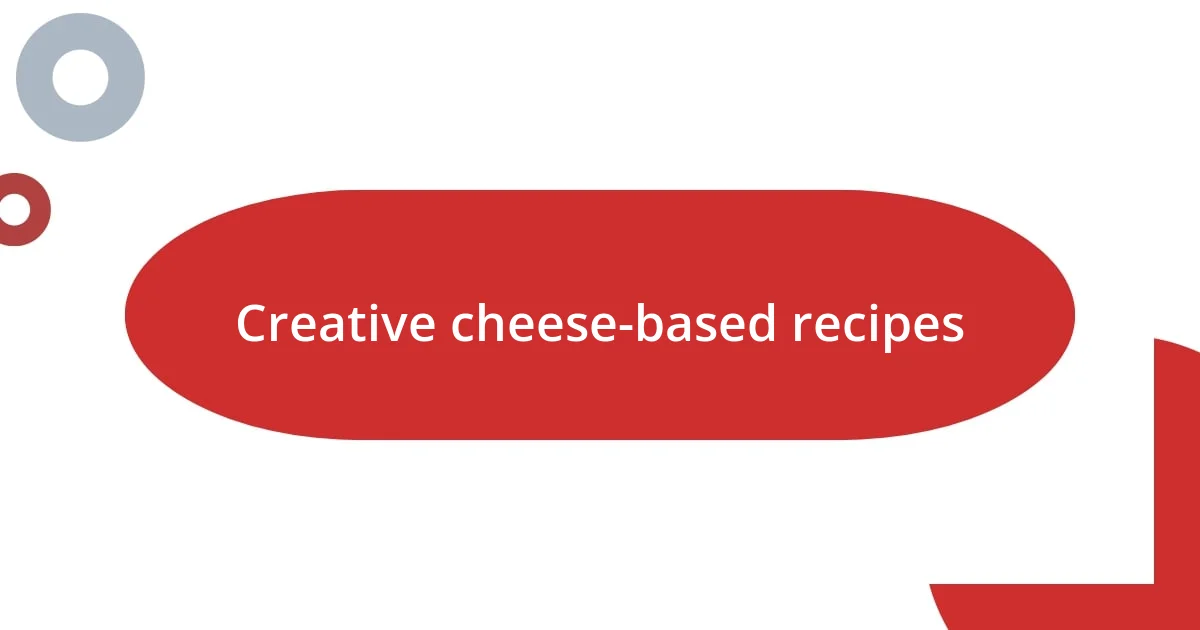
Creative cheese-based recipes
One creative cheese-based recipe that I absolutely adore is mac and cheese with a twist. Instead of sticking to the classic cheddar, I mix in a blend of creamy goat cheese and tangy blue cheese. When those cheeses meld together, it creates an unforgettable depth of flavor. I remember making this dish for a cozy dinner with friends, and the sheer joy on their faces as they took that first bite was priceless. Isn’t it amazing how a bit of experimentation can turn a childhood comfort food into something gourmet?
Then there’s the delightful world of cheese boards. I love to assemble a variety of cheeses, from nutty Gruyere to sharp aged cheddar, paired with fruits, nuts, and artisan crackers. It’s not just about cheese; it’s about creating an experience. I recall hosting a gathering where everyone participated in choosing their favorite combinations. The laughter and discussions about our personal pairings turned into a heartfelt celebration of flavors. Have you ever noticed how cheese brings people together in such a unique way?
Lastly, I can’t resist sharing my love for cheese-stuffed peppers. I like to hollow out sweet bell peppers and fill them with a mix of ricotta, herbs, and spices before roasting them to perfection. The way the cheese bubbles and caramelizes creates a burst of flavor with every bite. I once served these at a family dinner, and it quickly became a cherished recipe that has everyone asking for seconds. Isn’t it incredible how cheese can not only enhance flavors but also turn meals into cherished family traditions?










